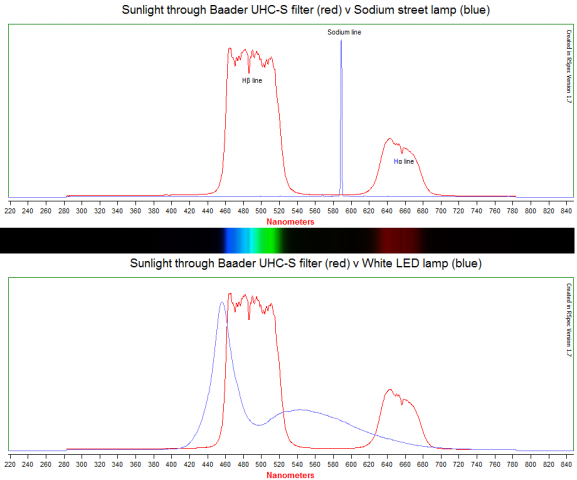› Forums › Spectroscopy › LED street lamps
- This topic has 9 replies, 5 voices, and was last updated 8 years, 1 month ago by
 Mr Jack Martin.
Mr Jack Martin.
-
AuthorPosts
-
5 October 2017 at 5:59 pm #573861
 Mr Jack MartinParticipant
Mr Jack MartinParticipantDoes anyone know how this will affect imaging of spectra ?
Also, a comparison with Sodium street lamps would be interesting.
Regards,
Jack
Essex UK
6 October 2017 at 12:50 am #578617 Paul LuckasParticipant
Paul LuckasParticipantI think I posted an image on this topic some time ago (light pollution lines that were not Na).
Generally, the software assisted sky background subtraction we use when processing spectral images pretty well mitigates all light pollution. I think it’s one of the best kept secrets of suburban spectroscopy (versus photometry and astrophotography).
Paul
29 October 2017 at 12:33 pm #578693 Mr Jack MartinParticipant
Mr Jack MartinParticipantPaul,
Which software are you referring to ?
Regards,
Jack
Essex UK
29 October 2017 at 3:01 pm #578696 Hugh AllenParticipant
Hugh AllenParticipant Hi Jack,
Hi Jack,Some time ago I used spectroscopy to illustrate the dangers posed by light pollution from white LEDs for astrophotography. My attachment shows how sunlight is filtered by a light pollution filter like the Baader UHC-S filter, to show what wavelengths are let through by the filter. The narrow emission from sodium is of course blocked by the filter whilst the broader emission from a white LED will leak through. However as Paul says background subtraction in spectroscopy would effectively remove light pollution at the risk presumably of introducing more noise. None of the spectra are response corrected
Cheers
Hugh
29 October 2017 at 5:27 pm #578699 Robin LeadbeaterParticipant
Robin LeadbeaterParticipantI live in a reasonably dark rural village but have half a dozen street lamps (a mix of LP sodium, metal halide and now LED), none of them are well designed, with very poor cutoff, even the LED (I suspect they went with the cheapest. The LED lamps probably do not even cut off the blue/UV spike that I believe decent models have these days. ) The pollution is significantly worse than when they were all LP sodium but sky background subtraction still deals with this very well, removing man made pollution and natural airglow/moonlight even when the sky is many times brighter than the spectrum eg
http://www.threehillsobservatory.co.uk/astro/spectra_46.htm
Robin
29 October 2017 at 10:02 pm #578700 Hugh AllenParticipant
Hugh AllenParticipantHi Robin,
How tall a background subtraction region would you select in such situations of higher relative light pollution?
Cheers
Hugh
30 October 2017 at 2:50 am #578701 Paul LuckasParticipant
Paul LuckasParticipantNone in particular Jack, though I use ISIS for processing slit spectra.
30 October 2017 at 8:26 am #578702 Andy WilsonKeymaster
Andy WilsonKeymasterIt is worth noting that all the spectroscopy software packages I have used do sky background subtraction. It is one of the standard processing steps when you usually select regions above and below the spectrum.
30 October 2017 at 12:46 pm #578703 Robin LeadbeaterParticipant
Robin LeadbeaterParticipantHi Hugh,
I typically use 30 pixels either side which is one of the ISIS defaults. I believe ISIS then uses the median value (to remove the potential effect of outliers). It is an interesting question as to what the optimal value is.
Very wide zones would minimise the additional noise from the subtraction but the background regions chosen potentially become less representative of the background where the spectrum is. (IIRIS, the forerunner of ISIS had various interpolation techniques to better predict the background where the spectrum is but these seem to have been dropped in ISIS). The effective removal of narrow lines (eg NaD, auroral lines etc) also becomes more difficult as the geometric correction (the correction of the slant and curve of the lines) has to be more accurate. (In any case narrow sky lines often tend to leave some artifacts after background subtraction).
What we should be aiming for it is the additional noise from the background subtraction operation to be small compared with the actual noise generated by the background present in the spectrum. I will have to go away and think about that calculation !
At the end of the day I suspect the main influence on background noise in the spectrum is the width of the spectrum binning zone. By making that as narrow as possible (while still including all the signal) we can keep as much background out as possible. (There are various clever optimal binning algorithms used by the professionaIs and ISIS has an option though I have not personally seen any significant improvement over choosing the zone manually)
Cheers
Robin
10 November 2017 at 10:07 am #578751 Mr Jack MartinParticipant
Mr Jack MartinParticipantTHANK YOU everyone for your comments.
We are lucky indeed to have software that filters out this nuisance.
Its only a matter of time before they arrive where I live, but at least the lights are switched off from 1 to 5am.
I have seen both types at night next to each other, a strange site !
Regards,
Jack
Essex UK
-
AuthorPosts
- You must be logged in to reply to this topic.
